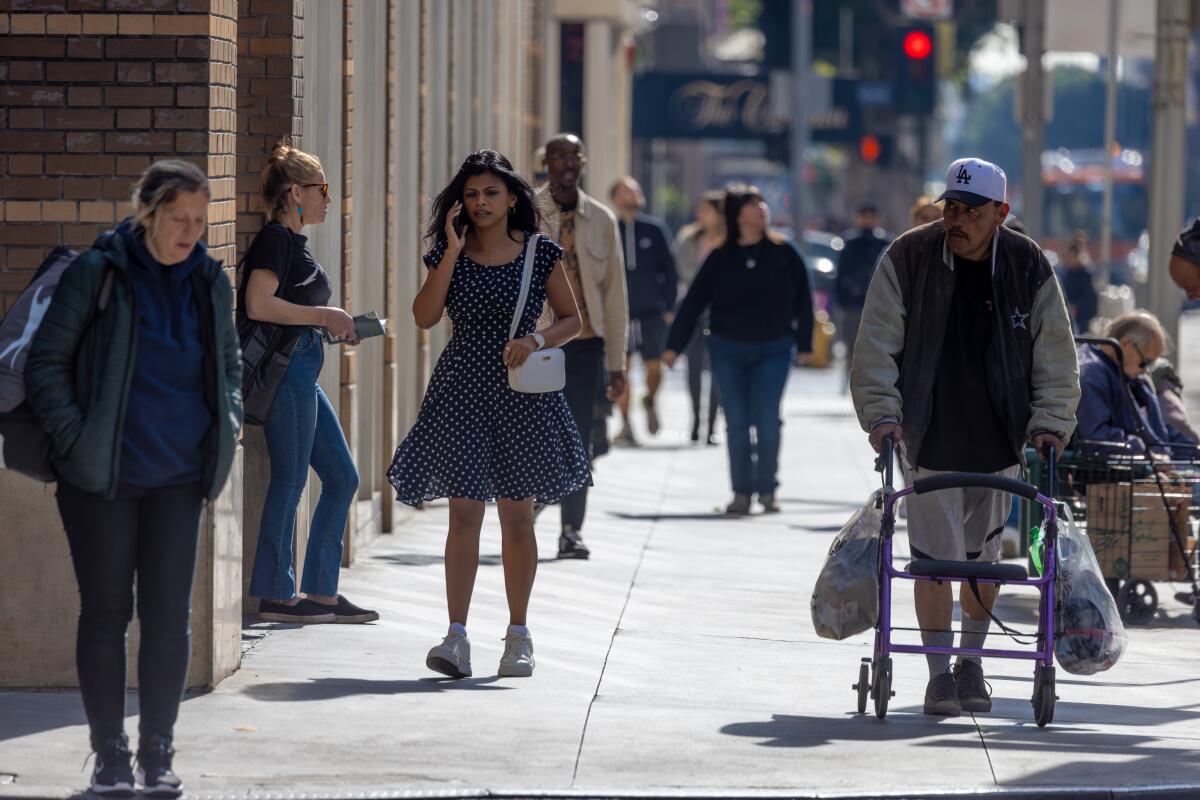California exodus left a gaping population hole. Can the Golden State finally bounce back?

- Share via
Despite a recent uptick in population, California still has a long way to go to make up for the exodus that began in 2019 and accelerated during the pandemic.
Though the state population grew 0.17% in 2023 — the first year of growth since the COVID-19 pandemic — California is still 1.2% smaller than it was in 2019, according to a Times data analysis.
If the state continues to grow at the same pace, it would take almost eight more years for California’s population to reach its pre-pandemic high-water mark.
But experts said it’s still hard to know how quickly the state can rebound.
California’s population declined largely because of a drop in international migration linked to pandemic travel restrictions, deaths from COVID-19 and a large number of people leaving for states with more affordable housing.
Some factors that led to the exodus are easing. Companies have been calling employees back to the office, making remote work situations more difficult. Major cities such as San Francisco saw some of the biggest increases in population last year, but they were also the hardest hit by the exodus.
Yet high housing prices remain a huge barrier and show no signs of easing.
A new poll underscores the challenges. The survey, conducted by the Los Angeles Business Council Institute in partnership with the Los Angeles Times, found nearly three-quarters of renters and those younger than 35 have given consideration to moving out of L.A. About 37% of homeowners and 26% of those 65 or older have also considered moving, the poll found.
“The state has experienced a chronic housing shortage for decades,” said Sarah Karlinsky, research director for the Terner Center for Housing Innovation at UC Berkeley.
The housing squeeze has put people “in substandard housing conditions,” and “a little bit of a breather in the housing market might allow someone who is doubling, tripling, quadrupling up to find a place of their own,” she said.
So many are “teetering on the edge or have fallen into homelessness,” Karlinsky said, and for them the state will need more subsidized affordable housing.
When the state adds to its housing stock, she said, it shouldn’t just be adding high-rises, but also “more affordable multifamily housing options” that might be smaller and cheaper.
Cities may begin to boost their population as businesses end work-from-home policies, but Karlinsky cautioned that “if everybody is driving back into their jobs, then that is going to be incredibly unpleasant.”
On a numeric basis, Los Angeles County has the most ground to make up: It still has about 340,000 fewer people than it did in 2019.
San Francisco, San Diego and Santa Clara counties are each around 40,000 people short.
Of the 58 counties in California, 25 counties gained population since 2019, representing a total of just under 12 million people, or 30% of the state population.
Three counties reported more than 5% population growth: San Benito, Yuba and Trinity, all rural areas with relatively few residents.
San Francisco County, the biggest percentage loser among large counties in the five-year span, had 5% fewer people than it did in 2019. Los Angeles County saw its population shrink by 3.3%.
In 2023, San Francisco County grew by 0.1% and Los Angeles County grew by 0.5%, far from making up for the losses of the last few years.
The Public Policy Institute of California projects that “it is unlikely that California will return to a period of rapid population growth.”
“Improving housing affordability through residential construction will be crucial to stemming outmigration, especially among middle- and low-income households,” the institute wrote last year.
In addition to lower population growth, the state will have an aging population, limiting a workforce “which is likely to shrink as many workers retire,” according to the institute.
The consequences of those two trends would be widespread and could include issues such as “fewer health care personnel to care for the growing number of older Californians,” the institute wrote.
Despite California’s overall diminished population, Gov. Gavin Newsom announced last month that the state’s exodus was over, referencing new data showing the state’s population grew in 2023.
The report showed “people from across the nation and the globe are coming to the Golden State,” Newsom wrote on X.
But the growth has not been substantial, according to experts, who say longtime population trends have been exacerbated by the pandemic.
The winners and losers of population change over the last five years are largely defined by the urban-rural divide.
Sutter County in Northern California and Imperial County along the Mexican border each reported growth of almost 2% in 2023, leading the state. On the other end of the spectrum, Mono County, along the border with Nevada, lost 2.5% of its population in a year.
For the first time since 2020, California’s population rose last year as COVID-19-related deaths waned and migration and immigration patterns shifted.
“It’s right to make note of this change in the direction of our population,” said Hans Johnson, a demographer at the Public Policy Institute of California, “but, by historic standards and compared to the population growth rate in the rest of the U.S., it’s a small number.”
If California continued its anemic growth from 2023, the state would be outpaced by most other states and would lose representation in the House of Representatives again in 2030, he said.
Even amid the turmoil of the pandemic, population trends persisted: Exurbs far from job centers “have long been the focus of growth in California” and continued to grow in the last five years, Johnson said.
In contrast, major urban centers such as Los Angeles County still “have room to get back to where they were,” he said.
During three consecutive years of population loss, “there were a lot of stories about how California was so dysfunctional that no one wanted to be here,” Johnson said, but the state is returning to “a more normal pattern of population change.”
More to Read
Sign up for This Evening's Big Stories
Catch up on the day with the 7 biggest L.A. Times stories in your inbox every weekday evening.
You may occasionally receive promotional content from the Los Angeles Times.















